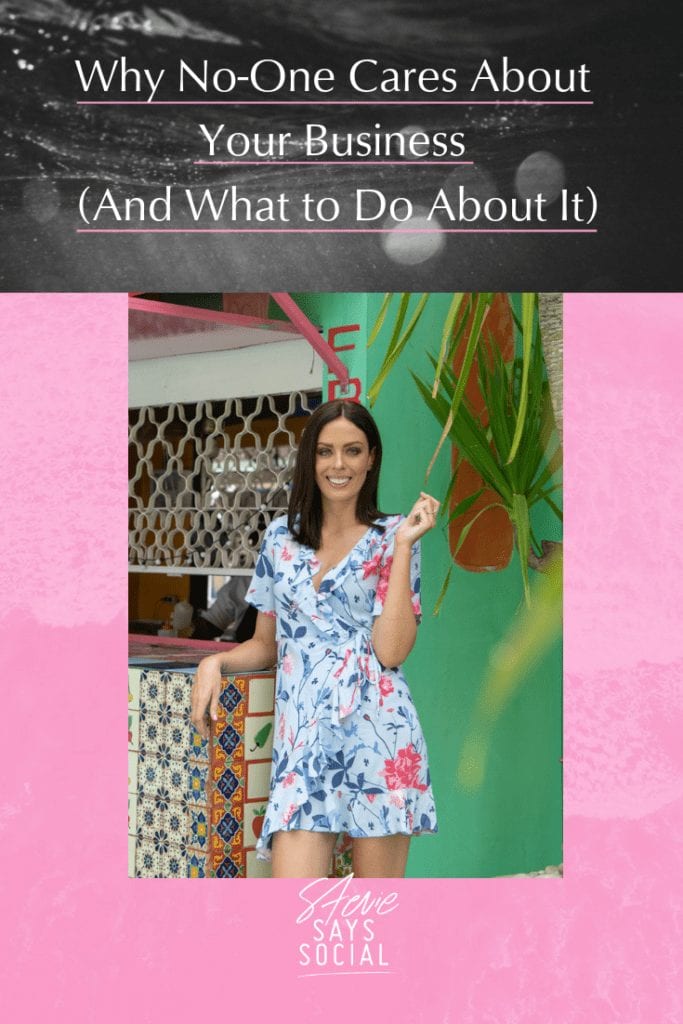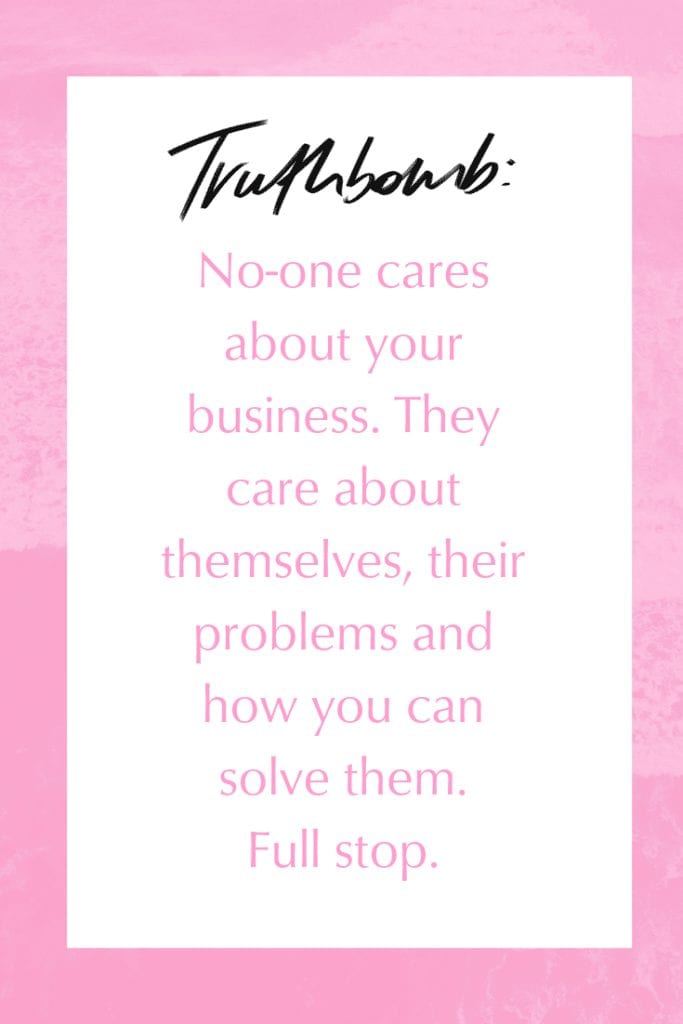Content Marketing done well makes your business to be an attraction business, with a steady pipeline of customers and clients clamouring to work with you.
In this episode, we go through what good content marketing is, why it rocks and how to incorporate it it regardless of the type of business you have.
So, let’s dive in!
Listen On: Apple Podcasts | Spotify
Transcript
Truthbomb: Nobody cares about your business.
Now I hate to break it to you guys, but it is TRUE. Nobody cares about your business. What people ultimately care about, in the end? Is themselves, and the problems that they have and then – when it comes to your business – whether you can solve them. That’s the bottom line.
And that’s really fundamentally important when it comes to thinking about how you market your business. When the penny first dropped on that for me way back when I was first getting into marketing it really changed everything for me.
I’d always really just considered marketing as something that was annoying. Even when I was little, I would look at ads on TV and it would just annoy me that they would be shoved into the middle something that I was watching. I’d look at ads in magazines and I would be annoyed they took up such a big chunk of a magazine that I had paid good money for.
And it wasn’t until I got a job at uni working at Red Bull that I first heard about something called attraction marketing.
Essentially, attraction marketing is complete 180 on the idea that advertising and marketing needs to be annoying. What Red Bull was doing was producing really cool content of extreme sports as a way of advertising themselves to adrenaline junkies in need of energy.
Rather than concentrating on ads telling people to buy Red Bull, they were giving people what they WANTED – extreme sport videos and the like – without ever pushing a marketing message onto people and they were selling bucketload of product.
It was only when I got into marketing after a quick career as a lawyer a few years on that I learnt that that was called CONTENT MARKETING.
So what is content marketing?
Here’s the fancy definition: In plain english, what it means is that it’s providing content that people find interesting and valuable to attract them to you, and to make them WANT to do business with you.
That content can be in written form, so blog posts for example, audio – for example podcasts – or it can be video format.
And it’s the exact opposite of the traditional approach to marketing, which centred around telling your customer all about how great you are and not-so-subtly trying to get them to fork over money. Have you ever been to a networking conference or dinner party with guest that do nothing but talk loudly about themselves? Annoying, isn’t it? That’s kind of how I feel about traditional advertising.
Here’s why I think content marketing really rocks so much.
Let’s go back to the time when I first got into marketing and learnt that that thing that Red Bull was doing was content marketing, and I became OBSESSED with it.
I implemented content marketing strategies into the businesses that I worked for, and then when I started my own business I literally built it from the ground up using content marketing. I now use it with my clients.
I have seen over and over the effect that it can have in completely transforming businesses.
I would not have a business today if it wasn’t for content marketing!!! It is 100% how I went from working full time in a corporate gig to having a full business with a pipeline of clients in six months.
Here’s how it helps:
- It develops the know, like and trust factor. Producing content as a way of marketing your business allows clients to get to know you. It build trust and leverage because you are helping them and providing value rather than selling them.
- It differentiates you in the marketplace.When I first started my business, I was looking in a Facebook group one day and someone asked for recommendations for someone to help with social media – there were 52 replies. I knew that in order to stand out, I had to produce content that set me apart and established me as someone relatable and who actually knew what they were talking about.
- It establishes you as an expert. Giving away some of your advice establishes you as an expert and thought leader.
- It wins you clients and customers. At the end of the day, when someone does eventually need your product or service, they are more likely to come to you because you have helped them consistently over time.
Here are some examples of content marketing in action.
Example:: Plumber
If you’re a tradie (let’s say in this case a general maintenance plumber), you should be producing content about how to do your own plumbing work. Put out little video demonstrations about common problems and things that you think people can easily fix themselves. Post them on Facebook, or Instagram, or little short snippets on Snapchat. Post live Facebook video of you fixing a common problem at a real clients house.
You might think of this as losing business, and there are surely little common problems you see everyday that you might be able to fix for $70. But by instead educating the masses, you’re gaining authority and trust and that’s the gateway to even bigger business.
Example:: Business Coach
If you’re a business coach, produce regular content on how to start and run a successful business. Host free workshops and stream them live on Facebook for potential clients to see. Or create a video series answering common questions that people have.
Example:: TOWN PLANNER/DRAFTSPERSON/ARCHITECT
If you’re a draftsperson, produce content on how to successfully build your own townhouses. Document the process of meeting with a client, producing drawings, the alteration process and the final product for those who have never been through the process before.
Example:: Skincare brand
Let’s say that you are product based. Say you own a skincare company. One excellent example that i saw the other day was mineral make up. The headline was ‘6 unexpected benefits of mineral make – what you need to know’. It was a facebook ad clearly being served to women with an interest in organic skincare and it had 129 likes and 25 comments and 27 shares. It was relevant and interesting to the target audience of people – me – and it wasn’t salely but the company sold mineral make up so guess what the logical next step was?
I could go on and on.
Most importantly, don’t be scared that giving away your best advice or your ‘specialised knowledge’ will hurt your business. The bottom line is that general advice can only be so good, and people will always still need your services. There’s two reasons for this:
- Most of the people who consume your content will never act on it, or want to do it themselves anyway. They’ll either give it a go and not do as well as a professional, and then end up using your services anyway. Or they’ll never even try, and go to you in the first place because your content shows that you know your stuff.
- In 99% of cases, general advice isn’t enough. A person will need additional context for their own individual circumstances, and this is where you will gain your business. They will need you to apply your knowledge to their specific circumstance.
This is where the ask finally comes in.
After providing so much helpful content and information consistently over time, your service based business will have built enough trust and authority to ask for the business.
The great news is that by this time, a lot of your potential clients will already be proactively coming to you.
“Right, I know content marketing is important for my business and I’m in!”, I hear you say.
Awesome.
Now, here are a few key considerations especially for service based businesses when putting together a plan of attack for producing content.
1. Think about who your potential customers and clients are.
In order to know what sort of content to put out, it’s absolutely critical that you know as much as you can about who your clients and customers are as possible.
If you’re not sure where to start but you already have a Facebook page, here’s a hot tip. Click onto your Facebook business page and along the top panel fourth from the left click onto ‘Insights’. Click on ‘people’ on the left hand tab. You’ll see the ages and sex of your Facebook fans, along with where they are from.
You’ll also want to think about what they like, where they shop, their average income – get as specific as possible because it will help you know how to focus your content efforts.
Also think about whether you current customers and clients are the ones that are best for your business. Perhaps you want to look at targeting people in a higher income bracket than the ones you currently attract? If so, note that down because it will guide your content and social media strategy.
2. Think about the social media platforms where those potential customers and clients are.
Once you have an understand of who your potential customers and clients are, you will need to find out which social media platforms are most popular with them. Make sure you are looking at statistics relevant to your area, as they can vary widely between countries.
There is a great summary of the main platforms for different sexes and demographics in Australia in 2016 in the Sensis Report.
Pick one or two that best suit your potential clients.
3. Think about the types of media that work best for your chosen platform.
In social media, context is everything and not all social media platforms are the same. The type of content that does very well on one platform won’t necessarily work on another.
For that reason it’s really important that once you know which social media platforms your audience hang out on, you tailor your content to suit it. The little nuances and differences in the way you need to present content on different social media platforms make all the difference. Here’s a quick summary of a few of the main social platforms:
- Facebook: Facebook gives you a lot of freedom when it comes to content. Images, video, text – whatever you like. One important thing to note, though, is that Facebook prefers native content. Which means content that is posted ON the platform and not linked from elsewhere. For example, video linked from Youtube is given far less ‘screen space’ and therefore attention than video uploaded to the platform natively. Facebook also prefers and prioritised whichever form of content is is pushing at the time – at the moment, this is live video but that could change tomorrow!
- Instagram: High quality visual imagery (and now video) is KING.
- LinkedIn: Be professional. If it helps people to expand their network or conduct business in a better way, your content has its place on LinkedIn.
- Youtube: Video, video, video which can come in one of two forms – entertain, or teach.
4. Think about the media formats that work best for you
In order to really nail your content efforts, you need to play to your strengths (or else consider outsourcing).
What are you good at? If you’re personable, confident and talkative and have no problems in front of a camera, then of course video is going to be the best platform for you. Did you score straight A’s in english? Writing blog posts and how to article is going to be more your thing.
Remember, content creation shouldn’t be hard. If you’re struggling to churn out blog posts because writing isn’t your strength, you’re just going to give up. Play to your strengths.
And remember, it doesn’t always have to be a polished production. Social media rewards authenticity and consistency, so be yourself and work with what you have. If you’re struggling with the idea of creation, think of it as documenting. Document, don’t create. Get 10 things out there by documenting what comes naturally and being yourself, don’t labour and get hung up over one perfect and polished piece of content (source: Gary Vaynerchuk).
5. Think about the ‘pain points’ of your potential clients and the things that they struggle with that you know you can help them with.
You know your business and your service better than anyone. What do people come to you struggling with? What is it that they find difficult? Make a list of 10 things – 100 things! – and produce content about that. One by one, literally tick every topic off your list by producing a piece of content about it.
And that’s it. Content marketing and social media go hand in hand, and for service based businesses it is this marriage that will produce the results you’re looking for and the greatest level of success for your business.
Keep Listening!
Listen On: Apple Podcasts | Spotify
Pin this!


Design a Simple Lifestyle Business With High Profits, Working 5-Hour Days & a Tiny Team
Get one actionable step each day for two weeks, and then weekly thereafter. It's 100% free — join 7000+ others.



